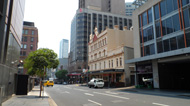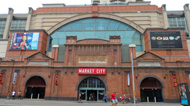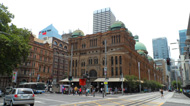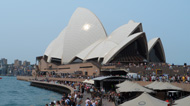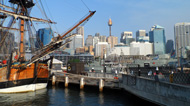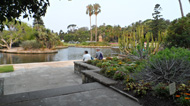Hotel Metro Marlow**** |
Market city Chinatown |
Queen Victoria Building |
The Rocks |
SYDNEY |
Sydney, capital of New South Wales and largest Australian city with more than 5 million inhabitants is known above all for the Sydney Opera House, a structure with a characteristic sail shape that rises near the harbor. The huge Darling Harbor and the smaller Circular Quay, which are located near the Harbor Bridge and the prestigious Royal Botanic Gardens, are very lively ports, while the Skywalk, the terrace of the Sydney Tower, offers a 360 degree view of the city and on the outskirts. Animals such as koalas, kangaroos, sharks and snakes find refuge at the Sydney Aquarium, Taronga Zoo and Wildlife Sydney Zoo. A real fish auction is held at Pyrmont's Sydney Fish Market and the restaurants serve the catch of the day. Throughout the city it is possible to taste multi-ethnic dishes, for example in Chinatown, in the Haymarket district, and in Italian restaurants in Leichardt. To reach places of interest outside of Sydney such as Bondi Beach and Manly Beach, famous for surfing, you can take the opportunity to take a ferry trip across the harbor. Sydney is the most populous city in Oceania and one of the most multicultural in the world. It is currently the 14th in the global cities ranking. The area around Sydney was inhabited by Aborigines for tens of millennia. The first British colonists arrived in 1788 with Captain Arthur Phillip and founded the city as a penal colony. Phillip named the colony New Albion, but for reasons that are not entirely clear it soon became known as Sydney, by Lord Sydney (Thomas Townshend), who sent permission to Phillip to found the colony. The colony was the destination of many deportations of prisoners, mainly of Irish and English origin. In most cases, as Australians are keen to remember, "prisoners" were accused of almost insignificant crimes or were simply exiled because they were unwelcome, often for political reasons, to the ruthless British aristocracy of the time. Since the transport of criminals stopped in the 1860s, Sydney has become a global cultural and economic center. In 2000 Sydney hosted the XXVII Olympics Games, while in 2008 it was the venue for the XXIII World Youth Day. Although urbanization has erased most of the traces of Aboriginal settlements, cave paintings are still found in some areas. Europeans began to take an interest in the area from 1770, the year in which Captain James Cook sighted Botany Bay (today a southern suburb of Sydney). Around the settlement, a small town soon began to form, which was gradually populated by immigrants in search of new life. As early as 1822 Sydney had banks and markets; in 1847, detainees now made up only 3.2 percent of the population. A particularly significant wave of immigrants took place during the 1851 gold rush. With industrialization, the expansion of the city accelerated, and at the beginning of the XXth century the total population was well over one million. Sydney has continued throughout the century to expand and welcome new waves of immigrants, first European and then also Asian, who have contributed to creating today's cosmopolitan atmosphere. The majority of sydneysiders are of British and Irish origin. More recently, large communities of Italians, Greeks, Serbo-Croats, Lebanese, Arabs and Asians have formed. In addition, the city also hosts an important gay community. The city offers various places that are worth a visit: primarily the Opera House, the undisputed icon of the city. Over 60 years ago, a young Danish architect, John Utzon, designed what is now considered one of the largest buildings in the world of all time. It is an artistic masterpiece that was created in adverse situations and that has become one of the richest artistic centers in the world, giving Sydney absolute notoriety. This masterpiece has been declared a UNESCO World Heritage Site. The Opera House has 1000 rooms, 300 corridors and hundreds of stories and secrets. Over 1800 performances take place in theaters every year. Next to the Opera House is the famous Sydney Harbor Bridge, nicknamed the "coathanger". It is an arch bridge with a suspended road surface. The bridge connects Sydney's business district with the northern area of ??the city, North Shore, crossing the length of Sydney Bay, formed by the mouth of the Parramatta River. The construction of the metal arch bridge in a reticular structure dates back to the late 1920s, and was completed in 1932. It has a length of 503 m and a width of 107 m, including 4 railway tracks and a 17 m wide roadway, the testing of which required the use of 72 locomotives. Its structure was a source of inspiration for the Tyne Bridge project in Newcastle upon Tyne, whose construction lasted from 1925 to 1928. It is passable by the underground, vehicular traffic and pedestrians. It can be climbed, and in fact many tourists are attracted to this adventure which can last more than three hours. Crossing it on foot is also an exciting experience to admire it in its majesty. The Rocks is Sydney's old quarter. It dates back to before 1800. Compared to the rest of the city, it has different architectural features, with lower buildings and narrower streets. The neighborhood was partially destroyed for the construction of the Harbor Bridge between 1920 and 1930. What was left was threatened with demolition last time in the 1960s, when it still had some crime problems. In the seventies these problems were substantially solved, and since then the neighborhood has been one of the symbols of Australia's brief history. Darling Harbor is one of the many bays in Port Jackson, the inlet overlooked by the city of Sydney. Darling Harbor is centrally located, and delimits the city, the city center, to the west. The docks and the area around Darling Harbor bay underwent renovation in 1988. A large pedestrian and recreation area was created there. Originally part of the Sydney harbor, in the late 1980s underwent a phase of profound decline, following which it was renovated on the initiative of the Minister of Public Works of New South Wales, with a project by Arup. Darling Harbor pulsates with night and day activity. It has grown to become one of Sydney's largest shopping, dining and leisure areas and also boasts convention centers that attract large crowds. In the area there are several recreational facilities including the maritime museum, the Sydney Aquarium, the Sydney Wildlife museum, the Imax Theater and various boats that can be visited, including some submarines. To visit in the city Hyde Park, a public garden in Sydney and is the oldest in Australia. It is 16.2 hectares large and has the approximate shape of a rectangle. Nearby are the Royal Botanic Gardens where centuries-old plants and ponds with various types of birds have found in this area the ideal place to live and reproduce. The Sydney Tower, generally called Center Point Tower is the tallest building in Sydney, with its 309 meters high. Its construction began in 1970 and was inaugurated and opened to the public in 1981. The tower does not house offices or apartments, but it was intended that it was the tallest building in the city and an attraction for tourists. The building at the base, part of the project, instead houses a shopping center. At the top of the tower, at over 260 m, there are two revolving and glazed floors, called Sydney Tower Eye, from which to admire Sydney Bay. Among the main tourist attractions there is the possibility to dine on the top of the tower, admiring the panorama of the city. It is part of the World Federation of Great Towers. China town is located in the central business district at Hay street. Taronga Zoo is the zoological garden of the city of Sydney in New South Wales. Officially opened on October 7, 1916, it is located in Port Jackson, the city port, particularly in the suburb of Mosman. The zoo is administered by the Zoological Parks Board of New South Wales through the Taronga Conservation Society, and the Dubonga-based Taronga Western Plains Zoo. Divided into eight zoogeographical regions, the Taronga Zoo is home to around 2600 animals on an area of ??21 hectares, making it one of the largest in the category. 7 Km. East from the center of Sydney, in the district of the same name is Bondi Beach, the most famous beach in the city.
From Sydney airport to the city center (Railway station) you can take the train which takes 15'/AU$ 35/A/R. In town, you can use the OPAL card to move around, which you need to top up online or by credit card. Remember to validate the card at the entrance of the tram and at the exit to avoid incurring additional penalties. From the Metro Marlow hotel to the airport, i booked the transfer with
AU$ 16.
